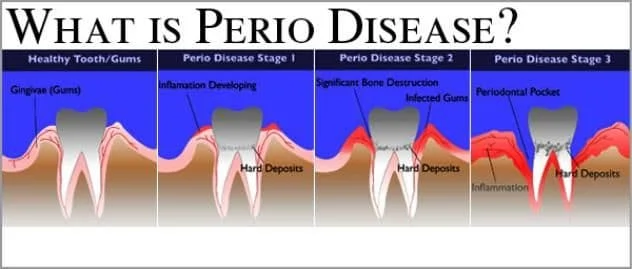What is Gum Disease?
Each tooth has a natural pocket between the tooth and the gum. In a healthy state, the depth of each pocket is 1-3 millimeters in depth. There are four stages in gum disease: Gingivitis, Early Perodontitis, Moderate Periodontitis and Advanced Periodontitis. When gingivitis occurs, the depth of the pocket increases to 4 millimeters due to the inflammation of the gum tissue. Early Periodontitis forms a 5 millimeter pocket due to the deterioration of bone around the tooth. Moderate Periodontitis creates a 6 millimeter pocket with moderate bone loss and recession of gum tissue. The disease continues to advance to Advanced Periodontitis creating a 7 millimeter pocket and greater due to severe bone and gum tissue loss.
At this stage, there is usually severe mobility of the teeth with little therapeutic therapy that will save the teeth. Bone and gum tissue can not be restored, therefore early detection and treatment is imperative in order to STOP the gum disease process before it is too late.
Click HERE for a video on understanding Gum Disease
Signs of Periodontal disease
If you notice any of the following signs, please call and make an appointment with our office as soon as possible:
- Gums that bleed when you brush your teeth
- Red, swollen, puffy or tender gums,
- Gums that have pulled away from the teeth
- Bad breath, that just does not want to go away
- Exudate or pus that is between your teeth a loose or several loose teeth
- A change in the way your teeth come together when you close your mouth.
- Any change in the way your partial dentures fit
Why can't you just clean my teeth?
Periodontal disease is a serious infection. Evidence now links gum disease to a variety of health concerns, including heart disease, stroke, diabetes, and other degenerative diseases that are life threatening. It's not just about your teeth anymore!
Periodontal disease can be a disfiguring disease. Your gums swell in size and become red and angry looking. They may bleed very readily. Your teeth may shift and dark spaces between your teeth may start showing. The teeth then become loose and may need to be removed.
Early detection as with other diseases is the key to successful treatment. Dr Wagner or the hygienist will routinely perform a gum (periodontal) disease screening exam. This is recommended at least once a year by the American Dental Association. The results of this examination will determine your periodontal status. If you have periodontal disease, your treatment will be personalized for you and your level of infection. A routine cleaning is not enough by itself to treat periodontal disease.
What is Root Planing?
Normal tooth cleanings remove plaque and calculus deposits from above the gum line. When these deposits extend below the gum line, root planing is necessary.
Root planing is performed with the same tools as normal cleanings, but the procedure is more aggressive. Often it is necessary to numb the affected area before the procedure. Once the accumulated plaque and calculus have been removed, the gums will heal, tightening around the teeth.
Depending upon the extent of disease found in the examination, root planing may be done over several office visits. In this way, your dentist can assess the progress of treatment, and alter tactics if necessary.
Simply stated, root planing may be considered as an extension of a "routine cleaning". A "routine cleaning" is intended to clean harden deposits that form above the gums. Over time, these deposits often form below the gums, on the roots. It is at this point that we recommend a more therapeutic procedure, called root planing.
What does it accomplish?
During this procedure the root surfaces are literally planed. This accomplishes several things:
- removes hard deposits and the bacteria they harbor
- creates a smooth root surface that is easier to keep clean
- reduces infection because the bacteria will not reattach to the smooth surface as readily
It is unrealistic to consider your therapy as a quick fix. Each person will respond differently to treatment. Future treatment recommendations will be made on the basis of your healing. For healing to be maximized it is imperative that you participate in your home care everyday.

